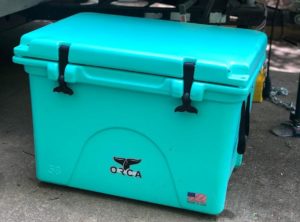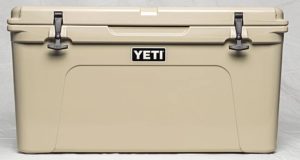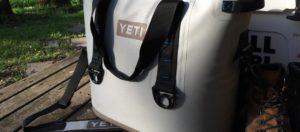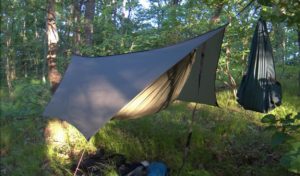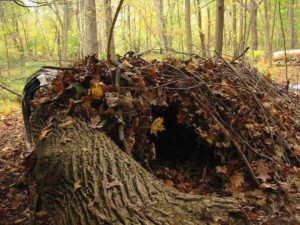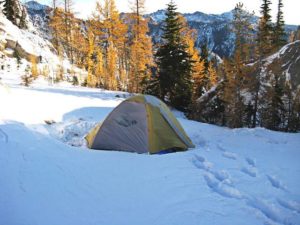After interviewing experts, considering 30 tents, and conducting some testing, we’ve determined that the $200 Mountain Hardwear Optic 2.5 tent is the 2-person, 3-season tent that we’d get, and what we recommend for most car campers and backpackers. This testing involved one late-spring snowstorm, a hailstorm, several temperature swings of 50 degrees Fahrenheit, and a battery of (additional) stress tests, during which the Optic 2.5 performed admirably. Its spacious living quarters, affordable price, and unique door design (it lets you rollback the outer flaps to reveal an unparalleled 180-degree panoramic view) make it a truly pleasant home away from home when the weather’s nice. When it’s not, the tent’s sturdy fabric and sturdy design keep you dry, warm, and safe.
The Mountain Hardwear aced every test from setup to teardown and was an overall joy to live with (and in). Setup was quick—in the four-minute range, even at night. The bells and whistles it had were well-thought-out and actually useful: plenty of pockets, big vestibules, hardy fabric that repelled even heavy snow, and a simple-clip rainfly to name a few. Its overall footprint naturally gives it the nod for interior space without feeling cavernous. It was comfortably roomy, even with four average-sized adults seated inside. The blue color admittedly made the interior feel a bit dark (when the doors weren’t rolled back), but this was a small price to pay for such a full-featured tent at a serious price point.
If $250 is out of your budget, you’ll be glad to know that these days you can get a brand new tent from a reliable brand for just $100 in the Kelty Outback 2. That’s the same price as a lot of Walmart/Target-brand tents, but in the Kelty you get a much better tent for your money. It’s nothing special compared to our top pick; it’s pretty heavy and uses fiberglass poles that aren’t as light as aluminum ones found on more expensive models, but if you only go camping a couple of times a year and don’t do much backpacking, you won’t mind the extra weight and will appreciate the savings.
The primary checks against the Kelty are the fabric, less dense than that of the Optic 2.5, and the poles, which are not lightweight aluminum like the Optic 2.5’s. Stepping up to the Optic will give you more space and higher-quality materials.
Why a 2 person tent 3-season tent?
Before we get into specifics on how we decide on the best camping tent, it’s important to note how we arrived at the conclusion that a 2-person, 3-season tent was the way to go for this piece. To be honest, the main reason is that if you look at the bestselling tents at outdoor gear retailers, it’s these that are the tents that most people buy—and there are several good reasons for that.
For starters, 2-person tents offer the best compromise between space when you want to be comfortable and packability should you ever decide to go backpacking. They’re also versatile: a 2-person can double as a spacious solo tent or can work overtime as a turkey-stuffed three-person shelter in a pinch. That’s why a solid two-person shelter is the best camping option.
As for the three-season part, we’re referring to Spring, Summer, and Fall, which should encompass the needs of most people. This means it’s built to withstand everything from harsh July sun to light hail and even some snow in early spring and late fall. It won’t protect you from heavy snow in the dead of winter, though. For that, you’ll need a four-season mountaineering tent, which is prohibitively expensive and too heavy for most people.
Don’t bother with a two-season though; you’ll want some protection just in case. Most manufacturers have a core product in the two-season category, the simplicity of a three-season backpacking tent is always appreciated.
For serious long-distance backpacking, all our picks in this piece trend on the heavier side. If you’re planning on spending weeks on end on the trail, you’ll want to look for a lighter option (perhaps the Flash 2 will fit that bill). And if you’re doing long-term base camping, you’ll want a taller, even bigger camping tent, which means you’re stepping up into a three- or four-person shelter.
Read our other camping buyer’s guides:
Hammocks | Ice Chests | Soft Coolers | Cookware Sets
Camping Tables | Water Filters | Sleeping Bags
Should You upgrade?
If you’re rocking a $100 four-person tent that you bought at Walmart a couple years back that you’re happy with, you’re set. But if you ever want to go backpacking, you’ll find yourself held back by the heavy tarp floor, skimpy rainfly that leaks like a sieve, and heavy fiberglass poles. If you ever want to go backpacking, we highly recommend getting something like our pick, or at least the step-down.
In recent years, tent technology has more or less stagnated, so it’s harder to buy a bad tent than a good one. So if you already have a two-person, three-season tent that you purchased within the past several years or so and it’s still going strong, feel free to hold onto it. You’ll be missing out on lighter poles and innovative layouts, but those aren’t worth paying a couple hundred bucks for if you already have something that fits your needs. However, if you find your rain fly is leaking, your poles are bent, and your floor has holes in it, it’s probably time for an upgrade.
As a final note, our picks are aimed at the pleasure camper, not the ultralight, through-trekking mountain man. If you want the lightest tent around for ultimate packability, our picks are not for you. Similarly, if you want to pay $400 for a super-tricked out shelter, we suggest looking at outdoor-specific publications.
How we pick our choices?
After scouring the web for the top gear-reviewing shops and speaking to some experts we had a good idea of what to look for. Think of a tent as a house with a foundation, a main building, and a roof. The rainfly is the roof that keeps the weather out, the tent body and poles comprise the rooms and doors, and the floor and how you stake your tent serves as the foundation. A good camping tent will excel on all three fronts while being easy to set up and take down, as well as light enough to carry around for several days in the wilderness. These days, if you spend enough money, it’s easy to find a good tent that meets all these criteria, so value is important.
Unfortunately, narrowing it down to three-season, two-person tents still leaves plenty major players in the running, so we had to develop some further criteria. Price was an easy one. We figured that most people who aren’t spending every weekend in the wilderness probably would gawk at anything over $300, so we set that as our upper price limit. Weight was another easy criterion to separate tents by, since anything over seven pounds is going to be a chore to carry for extended periods of time. We also gave preference to tents that came highly recommended by experts and other reviewers.
The foundation of any home is where the quality comes in. It’s imperative to focus on materials. For the floor of any tent, you’ll find a heavy denier fabric that’s reinforced in key places. This type of construction comes from years of testing and research, and we’re always looking for ways to make fabric lighter and stronger.
The body of the tent itself should also be solid. Look for a freestanding tent with a simple pole configuration. This makes for easy setup. When it comes to the tent itself, target a three-quarter mesh tent body.
As for the roof/rain fly, in addition to protection from the elements, no tent is complete without a vestibule. This is typically a part of the rain fly and helps protect the entry and can be used to house gear and boots. It’s an under-valued feature.
With that in mind, we were able to justify not testing most of 40+ initial candidates for one reason or another. The price criteria eliminated about half of the would-be contenders off the bat. Other contenders rang up at the right price but lacked important features like two doors, which you want for easy entry and exit without waking your tentmate. Still, others were eliminated from contention simply for not offering enough to justify their price.
With all that in mind, we eventually narrowed things down to five highly recommended tents that represented a variety of styles and prices:
Mountain Hardwear Optic 2.5 ($240) – This tent took the outdoor industry by storm from its launch at the annual Outdoor Retailer trade show in August of 2013, where it garnered Gear Junkie’s Gear of the Show. This model then went on to nab Backpacker’s Editor’s Choice for 2014.
Kelty Outback 2 ($100) – This tent is a newer version of the Kelty Discovery 2, and its price-to-weight ratio stands up in relation to the other tents in the test.
REI Half Dome 2 Plus ($189) – We used this model as our baseline for a two-person tent, as it’s a long time favorite and now in the BACKPACKER Gear Hall of Fame. Gear Institute gave it the nod for a sub-$200 tent, and Outdoor Gear Lab tipped it as a go-to for a cheap option.
Kelty Trail Logic TN2 ($250) – Backpacker Editors’ Choice 2014, with two large vestibules, a novel packing system, and lightweight construction.
Our pick
Mountain Hardwear Optic 2.5
The Mountain Hardwear was a pleasure to live with (and in). Setup was in the four-minute range, even at night, and includes extras that are actually useful. The fabric is tough and repelled even heavy snow.
- Industry leading DAC Pressfit™ poles
- Doors on adjoining sides roll back to offer huge view and easy access
- Two mesh doors with dual-slider zipper for easy entry and exit
- Dual vestibule design creates a dry entry into tent and room for gear storage
- Internal pockets help keep you organized
The Optic 2.5 fit our criteria with the right durability-to-weight ratio, plus the ease of setup and interior organization we expect from a high-end piece of gear. Yet, at $250, it can be had for a middle-end price. We were most impressed with the ratio of features to price and the overall square footage. It sells the extra half of a square foot, and it delivers on the promise of a three-season tent with bells and whistles. We acknowledged the slight weight penalty while kicking back and soaking in the widescreen view from our new favorite backcountry front porch.
The killer app on this tent, so to speak, is that you can pin back both doors all the way to the opposing pole, opening up one half of the tent and exposing the mesh canopy for 180-degree views. It’s great for stargazing and ventilation on muggy nights.
The large footprint of the Optic itself is another major selling point. Its 37 square foot footprint is a full 7 sq. ft. larger than the already roomy runner-up Sierra Designs. This gives you more space to stretch out and store gear when the going gets rough. It also means you can squeeze room for a third person in a pinch.
Extras aside, however, first and foremost, a tent should protect you from the elements. It doesn’t matter how light and how many pockets your tent has if you wake up in a soaked sleeping bag after a storm. The Optic 2.5 shines in this respect, even under heavy rain and snow.
After a three-hour downpour, the doorways started drying before the rest of the tent. And there was no demonstrable interior condensation due to its mesh walls and ample separation between tent canopy and rainfly. The exterior condensation evaporates within an hour, while the rest of the tent continues to dry. The total dry time on the Optic’s 75-denier coated polyester is at just over an hour.
Where the Optic 2.5 really shines and stands up to it’s three-season durability is during a freak hail and wind event. Despite truly trying circumstances, its cone shape and vestibule angles shed gusts and repelled pea-sized hail with ease.
Setting up the tent is straightforward both during daylight hours and at night using a headlamp. Its support structure consists mostly of an exoskeleton of two long cross poles that clip into four clips and one short top pole that clips the canopy together with two inserts on each end.
A large D-shaped plastic carabiner clips all three poles together and creates the tension that keeps the tent taut. It sounds more complicated than it is. For comparison, this system is slightly more intuitive and durable than the REI Half Dome’s connector poles, which required you to insert poles into sleeves that could be prone to tearing over time.
On the inside, the Optic 2.5 features four sidewall pockets that each can fit a book, a pair of glasses, and a headlamp with ease. We fit two 50-L packs (standing) with ease in the larger side vestibule, which seats a person. For ease of access, the main in and out happens via the slightly smaller front door, which can house two pairs of shoes and two day packs.
Disadvantages
One minor quirk is the velcro placements on the primary door. Each time you zip and unzip the door, you have to unfasten the velcro—a nitpicky annoyance, but when you think of the main interface of any tent, the doors, you know you want to be able to get in with ease.
That said, it’s actually a bit of a blessing in disguise. The placement—low down the zipper near the ground—means that it will stay fastened after zipping from the inside, a bonus for weather protection in the squall-like conditions we encountered at 5,400 feet on Colorado’s Front Range. Besides, the stickiness of the velcro will naturally slack after repeated years of use.
Campers who slept on the inside of the tent mentioned having to lean over their partner to unzip either door, but that’s not a problem if done right.
Lastly, at 6.3 pounds including poles, stakes, fly, and stuff sack, the Optic 2.5 is on the heavy side. But that’s not backbreakingly heavy, especially given how much more space you’re getting.
A step-down: Kelty Discovery 2
If you’d like to spend a lot less, the Kelty Discovery 2 is a solid option. Although it’s pretty heavy and uses fiberglass poles (rather than aluminum), you’ll appreciate the savings if you don’t plan on camping or backpacking often.
At the bargain level, the Kelty Discovery offers basics for under $100, and throughout our tests, it held up to the weather as well as any other tent. If you don’t mind the weight increase (it’s 6 lbs., 7 oz. despite its smaller size) and don’t plan on using it more than a couple of times a year, it’ll fit your needs just fine. The hefty fabric repelled the elements and the interior space was ample.
Overall, it’s a capable tent at a great price. Far-lower-quality tents are out there at the Targets and Walmarts of the world for almost the same price, so a brand name like Kelty on a tent at this price and weight shows you can shave off dollars from your budget without sacrificing quality.
This model only features one door and a basic, cross-pole construction. Four interior pockets were a nice touch for interior gear organization. Yes, the fiberglass poles were the heaviest in the test and the most likely to snap under serious strain, but if you just want something to protect you from the elements and insects a couple times a year, this will do the job better than anything in the price range.
What about family tents?
Some readers have inquired about tents for families. The answer to this largely depends on the size of your individual family, of course. Our existing top pick can fit 2-3 adults with room to spare, so if you have two adults and a kid, or two kids and an adult, the top pick may work. There is, however, a larger version of our top pick from Mountain Hardwear, which may be better if you have a slightly larger household.
If you need even more space, our step down/budget pick (the Kelty Discovery) comes in versions for 4 people and 6 people.
Care and maintenance
Picking a tent location is one of the most important aspects to tent care. Site selection and preparation will help the lifespan of your gear.
Upon arriving in camp, find a flat, relatively root- and debris-free spot. Clear out rocks, branches, and any sharp objects before unpacking your tent, and then unfurl your shelter. Always stake out opposite corners first, and then switch to the other opposing corners. This ensure a taut pitch before placing poles and clipping the canopy to the poles. One golden rule: do not step on tent stakes. You are likely to bend or break them. If the ground is more like concrete and you’re having a tough time getting stakes into terra extra-firma, then you can use a rock or a stick. If you are car camping, a small mallet is a helpful tool.
When packing up your tent, it’s important to shake out the interior to make sure no dirt, pebbles, or stray debris gets packed up into the bag. One way to do this is to unstake your tent, leaving the poles and canopy clipped, and open a door. Then raise the tent over your head and shake it out. Be careful in windy locations, as your tent will turn into a parachute. Once you’ve unclipped and folded up your poles, you can simply stuff you tent into your stuff sack, without any need for rolling or folding. In fact, rolling and folding a tent can cause creases and wear the fabric in the same spot, which will weaken it over time.
If you have to pack up your tent while damp or wet, be sure to set up and air out upon returning home. If you are headed to another campsite, you might want to unpack your tent during a lunch stop to dry out. A wet tent is a potentially moldy tent, so don’t store your shelter when wet.
The competition
Rounding out the middle of the test was the Kelty TN 2. This tent suits up with good intentions and a decent feature set, but it did display some design flaws in the pole setup: the triangle at the apex of the tent, formed by the crossing poles, exposed weakness during wet snow and continuous downpour, and this area of the rain fly collected serious water during testing. It did not leak into the tent, so the fabric rating held up.
One primary selling point of this tent is the near 270-degree viewshed that’s exposed when the rainfly is clipped back, exposing the interior from rough shoulder to foot, with head and upper body still covered by the fly. You can even roll it back and clip it down without leaving the tent, which is nice if the weather turns on a dime in the middle of the night. The stakes on this tent, however, were serious pain inducers, with a “plus” (+) construction that really ground in the palm of campers hands — and this stands out as a major interface issue. Zippers, pole clips, and stakes are the primary tent-to-user interface moments, and good tent design should minimize those pain points. The Kelty stakes causes some painful moments. Yes, you can use a flat rock or a wide stick to really depress stakes, but you always want to be able to palm them and push them in the ground. This fly featured the most sag of any tent over the course of the test, and we adjusted every other day to reset a taut pitch.
The REI Half Dome
On the lower third of the test we featured a classic: the REI Half Dome. This tent is simple, and it’s tried-and-true: a basic four-square tent with two doors. Minor bells and whistles include a few interior pockets and struts for ventilation between the tent body and the rain fly. The weight and the footprint of this tent are middle of the pack. Your money will not go to waste on this tent. But at the same time, there’s a $50 upgrade in the Optic 2.5, and you’ll get more versatility and comfort for that price jump.
The setup on this tent is quirkier than the others, with a cross pole inserted into a plastic sleeve, which, if broken, renders the tent untaut. We did not break this piece, but the concern is that if this highly custom piece breaks, it’s not easily fixed. The setup, however, is tight and makes for a good pitch that withstood prolonged exposure. The compression-style tent bag made for increased packability inside a backpack, and it reduced bulk.
The rest of the competition
MSR recently launched a new tent called the Elixir 2. It has two doors for $250, and it has a novel pitching system. It’s a pretty solid tent, and is set as an Amazon choice.
Below is a roundup of the 20 tents that did not make the test cut. All of these selections features four-plus reviews on either Amazon, Campmor, or REI, and most did not make the cut due to weight (above six and a half pounds), or lack of internal features. The picks in bold are worth looking into deeper if you want to price or feature shop. ALPS Mountaineering, Eureka, and Kelty have numerous two-person options ranging from $100 to $200. We primarily focused on 2013 tents to test, and many of these have been on the market for some time. We picked the Kelty Discovery as our budget option, though a serious bargain hunter might target the Coleman Hooligan 2 or the Eureka Tetragon 5. All prices are the manufacturer’s price, and you’ll likely find many of these tents for much bigger discounts.
Coleman Sundome 2 – Can’t beat the price, but certainly might want longevity with high-quality fabric and poles. Staking out guylines is an antiquated practice that adds clutter to your camp. Read: Not fun to trip on a tent line on a late-night bathroom break. $64, 6.4 lbs.
Eureka Apex 2XT Tent – Not designed for backcountry use. Cheap poles, and from user reviews on Amazon, the netting lets in condensation and overall the tent does not sustain pitch in high winds. $159, 5 lbs., 21 oz.
- Lightweight backpacker tent sleeps two (7' 5" by 4' 11" floor; 36.5 square foot area)
- Full vestibules on each side (6.7 square foot apiece) for stashing your gear out of the way
- Double-coated StormShield polyester fly and polyester bathtub floor provide excellent weather protection
- Well ventilated by one entire wall of no-see-um mesh, protected by Stormshield polyester fly
- Center height of 43.5 inches; weighs 6 pounds, 5 ounces
Marmot Limelight 2 – Hard to pack into the stuff sack and poor ventilation were the checks against this shelter. $198, 5 lbs.
Alps Mountaineering Meramac 2 – A tight squeeze for two with gear and questionable floor material, but at the right price and weight. $130, 5 lbs., 2 oz.
- Easy assembly with a free-standing, two-pole design and shock corded fiberglass poles
- Polyester fly resists water and UV damage, while providing an awning over each door
- Fully equipped with storage pockets, gear loft, steel stakes, guy ropes, two awning covered doorways, two zippered windows and large side mesh panels
- The ALPS Mountaineering Meramac Tent is on our best sellers list; a perfect tent for your next adventure
- Base Size: 5' x 7'6, Center Height: 48", Total Weight: 7 lbs. 9 oz., Color: Sage/Rust
Kelty Trail Ridge 2 – Another tent with dubious flooring and lackluster ventilation that leads to condensation. $160, 5 lbs., 8 oz.
Big Agnes Seedhouse SL 2 – A tight vestibule, lightweight and potentially rippable tent body fabric, plus condensation issue. $300, 3 lbs., 1 oz.
ALPS Mountaineering Taurus 2 – Ultra-heavy tent body and poles. Vinyl exterior windows do not close, plus taller campers might feel the squeeze. $120, 7 lbs., 7 oz.
MSR Hubba Hubba – A top brand that nearly made the cut, but a lack of internal features kept it out of this rounds. A solid option, however, at a reasonable price. $260, 4 lbs., 8 oz.
Kelty Grand Mesa 2 – One-door tent with a small vestibule and fiberglass poles. $120, 4 lbs. 5 oz.
ALPS Mountaineering Mystique 2.0 – Not freestanding, and footbox features condensation issues. $220, 5 lbs.
Eureka AlpenLite 2XT – Massive weight penalty on this tent meant we could not consider it. $272, 7 lbs., 7 oz.
Mountainsmith Morrison – Good entry level tent with a thin fabric floor and minimal storage. $180, 4 lbs., 7 oz.
REI Passage 2 – A classic dome tent that sleeps two but is on the bulky side. Best for car camping. $159, 5.5 lbs.
Marmot Ajax 2 – A tight vestibule and a tight fit for two sleepers filtered out this shelter. $180, 5 lbs., 5 oz.
REI Camp Dome 2 – An ideal entry level camping tent, not for lengthy backpacking. $119, 5 lbs., 6 oz.
Coleman Hooligan 2 – Super heavy, not freestanding, and the rain fly is tough to manage. $75, 8 lbs., 1 oz.
GoLite Imogene UL 2 Tent – This tent is right at the price point for our review, but it’s a bit cramped for two and has issues in humid conditions. $300, 2 lbs., 7 oz.
Eureka Timberline SQ 2XT – An A-frame style tent that trends on the heavy size with aluminum poles. Main gripe is weight. $229, 7 lbs., 3 oz.
Eureka Spitfire 2 – Not a freestanding tent, which was part of our basic criteria. $155, 4 lbs.
Kelty Acadia 2 – This is just plain too heavy for our review. $100, 7 lbs., 8 oz.
Wrapping it up
Make no mistake: this is a superior lineup of tents, though with some minor flaws. We have a standout in the Optic 2.5, but depending on your price sensitivity and feature requests, you might walk out very happy with the hall of famer (the REI Half Dome). And if you’re seriously under wallet-tightened measures, going for the Kelty Outback won’t leave you low and soaked in a torrential downpour.







